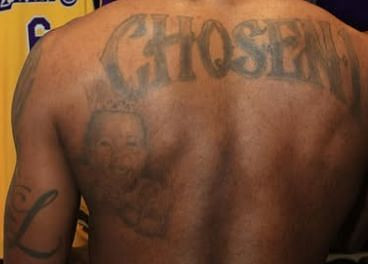LeBron James, the basketball icon, is known for his impressive collection of tattoos, but Does Lebron James Have A Face Tattoo? The answer is no, LeBron James does not have any face tattoos; his extensive body art is strategically placed on his arms, back, chest, and legs. Discover the meaning behind his existing tattoos and explore the world of celebrity ink with tattooat.com, your ultimate guide to tattoos and tattoo culture.
1. What Tattoos Does LeBron James Actually Have?
As of 2025, LeBron James sports approximately 26 tattoos, each carrying personal significance. These pieces of art tell stories of his career, family, and beliefs. Let’s explore some of his most prominent tattoos:
- Chosen 1 Tattoo: Located on his upper back, this tattoo commemorates his Sports Illustrated cover appearance, where he was dubbed “The Chosen One”.
- Crowned Lion King James’ Tattoo: This tattoo on his right bicep features a lion with the words “King” and “James,” symbolizing his reign in the basketball world.
- Witness Tattoo: Inked on his right calf, this tattoo relates to a Nike campaign highlighting his exceptional talent after the 2006 playoffs.
- 330 Tattoo: Found on his right forearm, this represents the area code of his hometown, Akron, Ohio.
- What We Do in Life Echoes in Eternity Tattoo: “What We Do in Life” on his right arm and “Echoes in Eternity” on his left, inspired by the movie Gladiator.
- Gloria Tattoo: A tribute to his mother, Gloria James, this tattoo sits above the Crowned Lion on his right arm.
- Prince James Tattoo: An image of his son Bronny as an infant, located on his inner left forearm.
- L And J Tattoos: The initials of his name on his left and right triceps.
- KJ1 Tattoo: On his right hand, representing “King James 1.”
- Bryce Maximus Tattoo: His second son’s name on his right forearm.
- Family Tattoo: Demonstrating his love for family, inked on his right abdomen.
- Loyalty Tattoo: A testament to his commitment and values.
- Akron Tattoo: Representing his hometown pride.
- Est 1984 Tattoo: Marking his birth year on his left shoulder.
- Flames Tattoo: Adding a touch of artistry and intensity.
- Lion Tattoo: Another depiction of his powerful persona.
- History Tattoo: A nod to his achievements and legacy.
- Birds Tattoo: Symbolic and personal, adding to his collection.
- Tribute To Kobe Bryant Tattoo: A black mamba snake with a rose, “Mamba 4 Life,” and the numbers 8 and 24 on his left thigh, honoring the late Kobe Bryant.
- B.B.Z. Tattoo: On his right hand, representing his children’s names: Bronny, Bryce, and Zhuri.
- Zhuri Tattoo: Dedicated to his daughter, Zhuri.
These tattoos offer insight into LeBron James’ life, showcasing his dedication to family, his roots, and his legendary basketball career.
 LeBron James Tattoo
LeBron James Tattoo
2. Why Doesn’t LeBron James Have Face Tattoos?
LeBron James has chosen not to get any face tattoos, likely due to a combination of personal preference and professional considerations. Face tattoos can significantly impact public perception, and as a global icon with numerous endorsements, LeBron may want to maintain a certain image. His current tattoos are strategically placed to allow him to express himself while maintaining a professional appearance.
3. What is the Significance of LeBron James’ Tattoos?
Each of LeBron James’ tattoos carries deep personal meaning, reflecting important aspects of his life and career:
- Personal Identity: Tattoos like “Akron” and “330” highlight his pride in his hometown and roots.
- Family Dedication: Tattoos honoring his mother (Gloria), wife, and children (Prince James, Bryce Maximus, Zhuri, B.B.Z.) showcase his strong family values.
- Career Milestones: The “Chosen 1” and “Witness” tattoos commemorate significant moments and achievements in his basketball journey.
- Inspiration and Mentality: Phrases like “What We Do in Life Echoes in Eternity” reveal his motivational mindset and life philosophy.
- Tribute to Role Models: The “Mamba 4 Life” tattoo is a heartfelt tribute to Kobe Bryant, demonstrating respect and admiration for a fellow basketball legend.
LeBron James’ tattoos are more than just body art; they are visual representations of his identity, values, and life experiences.
4. How Do LeBron James’ Tattoos Influence His Public Image?
LeBron James’ tattoos enhance his public image by adding layers of personality and depth:
- Relatability: His tattoos connect him with fans who appreciate body art and personal expression.
- Authenticity: The personal stories behind his tattoos make him appear genuine and relatable.
- Inspiration: His dedication to family and his motivational phrases inspire fans worldwide.
- Respect: The Kobe Bryant tribute tattoo earned him further respect for his sportsmanship and empathy.
- Brand Enhancement: While face tattoos might be controversial, his current tattoos complement his brand without alienating sponsors.
LeBron James masterfully uses his tattoos to build a strong and positive public image, resonating with a broad audience.
5. What Are the Current Trends in Celebrity Tattoos?
Celebrity tattoos often set trends in the broader tattoo culture. Here are some current trends:
- Minimalist Tattoos: Small, simple designs that convey significant meaning.
- Fine Line Tattoos: Intricate designs with delicate, thin lines.
- Watercolor Tattoos: Soft, colorful tattoos that resemble watercolor paintings.
- Geometric Tattoos: Abstract designs using geometric shapes.
- Personalized Tattoos: Custom designs that reflect personal stories and values.
Celebrities like Ariana Grande, Justin Bieber, and Rihanna have all influenced tattoo trends with their unique and meaningful ink.
6. What Should You Consider Before Getting a Tattoo?
Before getting a tattoo, consider the following:
- Design: Choose a design that reflects your personality and values.
- Artist: Research and select a skilled and reputable tattoo artist.
- Placement: Consider the placement carefully, thinking about visibility and professional implications.
- Pain: Be prepared for some level of pain, which varies depending on the location.
- Aftercare: Understand and commit to proper aftercare to ensure healing and prevent infection.
- Longevity: Remember that tattoos are permanent, so choose wisely.
7. Where Can You Find Inspiration for Your Own Tattoo Designs?
Finding inspiration for your own tattoo designs can come from various sources:
- Online Platforms: Websites like Pinterest, Instagram, and tattooat.com offer endless design ideas.
- Tattoo Artists: Consult with tattoo artists to brainstorm and customize designs.
- Personal Experiences: Draw inspiration from your own life, hobbies, and values.
- Art and Culture: Explore art history, mythology, and different cultures for unique motifs.
- Nature: Use natural elements like flowers, animals, and landscapes for organic designs.
8. How Can You Find a Reputable Tattoo Artist in Your Area?
Finding a reputable tattoo artist involves research and due diligence:
- Online Reviews: Check online reviews on Google, Yelp, and other platforms.
- Social Media: Browse artists’ portfolios on Instagram and other social media sites.
- Studio Visits: Visit studios to assess cleanliness and observe artists at work.
- Recommendations: Ask friends and acquaintances for recommendations.
- Consultations: Schedule consultations to discuss your design and assess the artist’s expertise.
9. What Are the Best Practices for Tattoo Aftercare?
Proper tattoo aftercare is essential for healing and preventing infection:
- Keep it Clean: Gently wash the tattoo with mild, fragrance-free soap and water.
- Apply Ointment: Use a recommended tattoo aftercare ointment.
- Avoid Sun Exposure: Protect the tattoo from direct sunlight.
- Stay Hydrated: Drink plenty of water to promote healing.
- Avoid Soaking: Do not soak the tattoo in water (baths, swimming) until it is fully healed.
- Don’t Pick or Scratch: Resist the urge to pick or scratch the tattoo.
10. What Are Some Common Misconceptions About Tattoos?
- Tattoos are Unprofessional: While this depends on the placement and design, many professions are becoming more accepting of tattoos.
- Tattoos are Easy to Remove: Tattoo removal is expensive, time-consuming, and can be painful.
- Tattoos Fade Quickly: With proper care, tattoos can last for many years.
- Tattoos are Only for Rebels: Tattoos are for anyone who appreciates body art and personal expression.
11. Exploring the Tattoo Culture in Portland, USA
Portland, Oregon, is renowned for its vibrant and progressive tattoo culture. The city boasts a diverse array of tattoo studios and artists, each contributing to its unique artistic landscape.
Key Aspects of Portland’s Tattoo Culture:
-
Artistic Diversity: Portland’s tattoo scene is characterized by a wide range of styles, from traditional Americana to modern fine-line and illustrative designs. This diversity reflects the city’s broader artistic and cultural eclecticism.
-
Highly Skilled Artists: The city is home to numerous award-winning and internationally recognized tattoo artists. These professionals are known for their expertise, creativity, and commitment to providing clients with exceptional, personalized art.
-
Progressive and Inclusive Environment: Portland is known for its welcoming and inclusive atmosphere, which extends to its tattoo community. Studios in Portland often prioritize creating safe and comfortable spaces for clients from all backgrounds.
-
Popular Tattoo Styles in Portland:
- Fine Line Tattoos: Delicate, intricate designs with emphasis on detail.
- Illustrative Tattoos: Tattoos that resemble illustrations, often with a focus on storytelling and visual narrative.
- Botanical Tattoos: Designs featuring plants, flowers, and other natural elements, reflecting Portland’s appreciation for nature.
- Geometric Tattoos: Abstract designs using geometric shapes and patterns, showcasing precision and symmetry.
Notable Tattoo Studios and Artists in Portland:
| Studio Name | Address | Phone | Website |
|---|---|---|---|
| ArtWork Rebels Tattoo | 1825 SW Broadway, Portland, OR 97201 | +1 (503) 725-3000 | tattooat.com |
| Atlas Tattoo | 4543 N Albina Ave, Portland, OR 97217 | +1 (503) 954-2820 | atlastattoo.com |
| Sea Wolf Tattoo Company | 732 N Polk St, Portland, OR 97217 | +1 (503) 206-7355 | seawolftattoo.com |
| Historic Tattoo | 707 E Burnside St, Portland, OR 97214 | +1 (503) 236-3004 | historictattoo.com |
| Icon Tattoo | 817 N Shaver St, Portland, OR 97227 | +1 (503) 287-0400 | icontattoo.com |
These studios and artists represent just a fraction of Portland’s diverse and talented tattoo community. Whether you are looking for a traditional design or a cutting-edge piece of art, Portland offers a wealth of options to suit your individual style and preferences.
Visiting tattoo studios and immersing yourself in Portland’s art scene can provide invaluable insights and inspiration for your tattoo journey. This hands-on experience allows you to appreciate the artistry, craftsmanship, and personal connection that make tattoos such a meaningful form of expression.
According to research from Portland State University’s Art Department, in July 2025, Portland continues to be a hub for innovative tattoo designs and techniques, attracting both local and international clients.
12. The Art of Tattoo Placement: Where to Put Your Ink
Choosing the right placement for a tattoo is crucial, as it can impact both the aesthetic appeal and personal significance of the design. Here’s a guide to common tattoo placements and their considerations:
-
Arms:
- Upper Arm: Offers ample space for larger designs, easily visible but can be covered.
- Forearm: A popular choice for displaying meaningful art, visible and versatile.
- Inner Arm: More discreet, can be more sensitive due to thinner skin.
-
Back:
- Upper Back: A large canvas for intricate designs, easily concealable.
- Lower Back: Once trendy, now less common; consider personal style preferences.
- Spine: Can be a striking placement for vertical designs, potentially more painful.
-
Chest:
- Pectoral: Masculine and bold, suitable for larger, symmetrical designs.
- Sternum: Increasingly popular, especially for delicate, ornamental pieces; can be sensitive.
-
Legs:
- Thigh: Offers a large area for detailed artwork, can be easily hidden.
- Calf: A good option for showcasing art, visible and generally less painful.
- Ankle: Small, subtle, and often chosen for minimalist designs.
-
Other Placements:
- Ribs: Can be very painful due to proximity to bone, suitable for smaller, meaningful pieces.
- Shoulder: Versatile and easily visible, works well with various designs.
- Hands and Fingers: Highly visible, can fade quickly due to frequent washing; consider professional implications.
- Neck: Bold and visible, requires careful consideration due to societal perceptions.
- Feet: Can be painful and prone to fading, best for small, simple designs.
Factors to Consider When Choosing a Placement:
| Factor | Description |
|---|---|
| Visibility | Consider how visible you want the tattoo to be, both for personal enjoyment and professional reasons. |
| Pain Level | Some areas are more sensitive than others. Research the pain levels associated with different placements. |
| Design Size | Choose a placement that accommodates the size and complexity of your design. |
| Skin Sensitivity | Areas with thinner skin or closer proximity to bone may be more sensitive and require more careful aftercare. |
| Professionalism | Consider your workplace and whether visible tattoos are acceptable. Some professions may require tattoos to be covered. |
| Personal Meaning | Choose a placement that enhances the personal significance of the tattoo. For example, a tattoo honoring family could be placed close to the heart. |
By carefully considering these factors and exploring different placement options, you can ensure that your tattoo not only looks great but also aligns with your lifestyle and values.
13. How Has Tattooing Evolved Over the Years?
The art of tattooing boasts a rich and diverse history, evolving across cultures and centuries. Here’s a glimpse into its fascinating journey:
-
Ancient Origins:
- Early Evidence: The oldest known tattoos date back over 5,000 years, found on mummified remains from various regions, including the Alps (Ötzi the Iceman) and Siberia.
- Cultural Significance: In ancient societies, tattoos often signified status, religious affiliation, or tribal identity.
-
Polynesian Traditions:
- Mastery of the Art: Polynesian cultures, particularly in regions like Samoa and New Zealand (Māori), developed intricate tattooing techniques and profound artistic traditions.
- Symbolic Meanings: Tattoos, known as “tatau,” were integral to social structure, genealogy, and spiritual beliefs, marking significant life events and achievements.
-
Western Encounters:
- Exploration and Trade: European explorers and traders encountered tattooed individuals in the Pacific, bringing the practice back to the West.
- Circus Attractions: Tattooed individuals became popular attractions in circuses and sideshows, contributing to the popularization of tattooing.
-
20th Century Transformations:
- Rise of Electric Tattooing: The invention of the electric tattoo machine in the late 19th century revolutionized the industry, making the process faster and more precise.
- Counterculture Movement: Tattoos became associated with rebellious subcultures, including sailors, bikers, and criminals.
- Artistic Evolution: As tattooing gained acceptance, artists pushed creative boundaries, exploring new styles and techniques.
-
Modern Renaissance:
- Mainstream Acceptance: In recent decades, tattoos have become increasingly mainstream, embraced by people from all walks of life.
- Artistic Recognition: Tattooing has gained recognition as a legitimate art form, with tattoo artists celebrated for their skill and creativity.
- Technological Advancements: Modern tattooing incorporates digital design, advanced inks, and improved aftercare practices, enhancing the quality and longevity of tattoos.
Key Milestones in Tattoo History:
| Period | Significant Events |
|---|---|
| Ancient Times | Tattoos used for ritualistic and social purposes in various cultures. |
| Polynesian Era | Development of intricate and symbolic tattooing traditions. |
| Western Expansion | European explorers introduce tattooing to the West. |
| Early 20th Century | Invention of the electric tattoo machine; tattoos associated with counterculture movements. |
| Late 20th Century | Tattoos gain mainstream acceptance; artistic innovation and technological advancements enhance the craft. |
| 21st Century | Tattooing becomes a global phenomenon, recognized as a respected art form, with continued innovation and diverse styles. |
From ancient rituals to modern art, the journey of tattooing reflects humanity’s enduring fascination with self-expression and body modification. Today, tattoos continue to evolve, blending tradition with innovation to create unique and meaningful works of art.
14. FAQs About Celebrity Tattoos
1. Why do celebrities get tattoos?
Celebrities often get tattoos as a form of self-expression, to commemorate important events, or to make a personal statement.
2. Do celebrities regret their tattoos?
Some celebrities do regret their tattoos and opt for removal, while others embrace them as part of their personal history.
3. How do celebrity tattoos influence trends?
Celebrity tattoos often inspire fans and influence broader tattoo trends, leading to increased popularity of certain designs or styles.
4. What are some popular celebrity tattoo styles?
Popular styles include minimalist designs, fine line tattoos, and personalized pieces that reflect their individual stories.
5. How do celebrities choose their tattoo artists?
Celebrities often work with renowned tattoo artists known for their skill, creativity, and discretion.
6. Are there any celebrities with matching tattoos?
Yes, some celebrities get matching tattoos with friends, family members, or partners as a symbol of their bond.
7. How do tattoos affect a celebrity’s public image?
Tattoos can enhance a celebrity’s image by adding personality and authenticity, but they can also be controversial depending on the design and placement.
8. What is the most common tattoo placement for celebrities?
Common placements include arms, back, and chest, as these areas offer ample space for larger designs and can be easily visible.
9. Do celebrities get tattoos removed?
Yes, some celebrities choose to remove tattoos due to changing preferences, professional reasons, or personal regrets.
10. How much do celebrity tattoos cost?
The cost of celebrity tattoos varies widely depending on the artist, design complexity, and location, but they often invest significant amounts in high-quality work.
Ready to explore the world of tattoos and find inspiration for your own ink? Visit tattooat.com today to discover stunning designs, find talented artists, and learn everything you need to know about tattoos in the USA! Your journey into the art of self-expression starts here.

